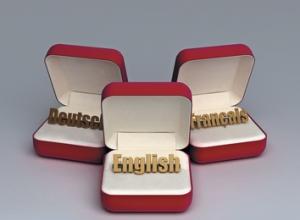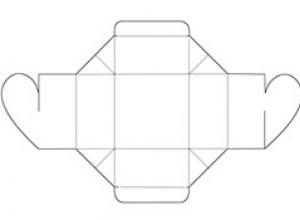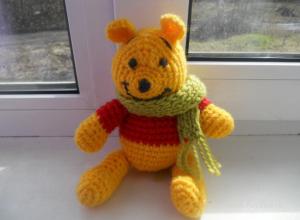Copybooks for children 5 6 years old letters. Recipes for children
The ability to write is one of the most important skills, along with reading, that any person should master (see also:). Many parents unreasonably believe that they need to start teaching their child as early as possible, that this skill is the highest indicator of the level of development. Is it so? Many experts agree that you should not start teaching your child to write until he is 5-6 years old. Teaching a preschooler to write beautifully is not an easy task; it requires composure, perseverance and attentiveness.
All parents want to be proud of their child and try to teach him to write at an early age. But this approach can only do harm if you don’t know how to deal with your child correctly.Children aged 3-4 years, for the most part, are fidgety. They want to run, jump, play, but not write out some letters and numbers in boring copybooks. If you still decide to teach your child to write, then remember: now you will need to practice penmanship with your child regularly, otherwise after a while he may forget everything you taught him!
Not everyone may like these activities, so he may begin to write letters and numbers quickly and sloppily, wanting to finish with them as quickly as possible and eventually move on to some more interesting things. All this can lead to the development of ugly handwriting, which will not be so easy to correct later. Let's figure out what experts are talking about: is it worth starting to teach children to write in preschool age, how effective will such classes be and their consequences?
Should parents teach a child under 5 to write?
Teaching children to write at 3-4 years old is not worth it for a number of reasons:
- Children lose the sense of novelty inherent in learning at school. When a student realizes that all they start learning in class is writing numbers and letters, he loses all interest in learning. The child becomes bored and lazy to complete the task. We are no longer talking about any incentive and joy to learn new things every day.
- Writing skills turn out to be incorrect. Two experts in the field of child development (physiologist Maryana Bezrukikh and early development specialist Lena Danilova) are convinced that the development of writing skills, including penmanship and speed writing, does not occur in one year, but gradually. This takes years. You shouldn’t throw all your energy into teaching your child to write beautifully. All this may negatively affect his entire style of writing in the future.

 Correct posture must be developed from a very early age, as soon as the baby takes his first pencil and sits down to draw at the table. This will help avoid many spinal problems in the future.
Correct posture must be developed from a very early age, as soon as the baby takes his first pencil and sits down to draw at the table. This will help avoid many spinal problems in the future. At first, a preparatory base will be sufficient for training. Teach your baby to sit at the table in the correct position, and also teach how to grasp a pencil or pen. Over time, you can begin the learning process, but remember that it is important to be consistent in your teaching techniques. Each number and each letter should be explained separately, explaining and comparing. A child is only able to fully evaluate the technique of writing a particular letter when he or she is closer to 5-6 years of age.
Haste in learning always only causes harm; it is especially important not to rush at first. By pushing your child, you will provoke him to make mistakes in writing individual elements.
Increasingly, irregularities in height and width and slope will occur. It will become almost impossible for your baby to connect letters into words. Then, upon entering first grade, the child will fall into the hands of a teacher who will be forced to correct many of your mistakes.
When should you start?
Dear reader!
This article talks about typical ways to solve your issues, but each case is unique! If you want to know how to solve your particular problem, ask your question. It's fast and free!
Usually, it is at school that we learn to write letters and numbers beautifully. Learning to write there takes place in several stages: first, children are shown how to sit at a school desk correctly, then how to hold a pen or pencil. Teachers give the child the first ideas about letters and numbers, talk about what height and width the lines and slopes in them should be, and show how to correctly connect them together.
Early mastery of accurate writing of numbers and letters does not guarantee the preservation of this skill in the future. It is important to position the hand so that the child gets minimally tired during the work. This skill, as well as the skill of beautiful handwriting, comes from regular practice. It is difficult to force a baby who loves to run and jump to sit at a notebook. When the parents succeed, their only goal is to finish everything quickly, so that everyone falls behind, and then run off to play. Such an incorrect approach risks ruining children's handwriting for a long time.
The child himself must want to learn to write, and until this time, classes can be carried out in a playful way
Let us conclude: it is advisable to engage with your child in a playful way. Any learning activity should be presented easily and naturally. Don’t rush to put a 3-4 year old child on a line with copybooks and notebooks. Wait a couple of years, then your successes with him will be more tangible and less painful. Until this time, you should only prepare your little hands for future writing.
Preparing a preschooler to master writing skills
All of the above does not mean that a 5-6 year old child does not need to be prepared for school, because before he begins to learn to write, it is necessary to master a wide variety of skills. This is where the help of parents will come in handy. To do this, it is necessary to pay attention to the development of fine motor skills and coordination of movements. Thanks to full development, the child will be able to write beautifully in the future, so that both his and your eyes will be happy. Teach your baby to do everything carefully, to show diligence and attentiveness. These are the skills that should be developed in children during the preschool period. We are talking about ages from 2 to 5 years. The following activities will help you do this.
Exercises to develop fine motor function
You can develop fine motor skills in different ways, for example, by modeling from plasticine
- finger gymnastics: a great option to stretch naughty fingers is to play together a game called “Twister”, only with your fingers;
- make a shadow theater using your hands;
- make applications from all kinds of materials (colored paper, felt, autumn leaves, grains, etc.);
- learning to cut out (first simple shapes, then more complex pictures);
- make drawings on semolina, sand (we recommend reading:);
- folding, paper modeling, origami;
- design;
- weaving bracelets and figures from rubber bands;
- activities with loose and small objects (cereals, legumes, pebbles): repeating a pattern, making a mosaic, stringing pasta on a string, etc.;
- modeling from clay, dough, plasticine;
- copybooks, coloring, drawing.
Remind them of the importance of posture. Pay great attention to your position at the table. In the future, while concentrating on the writing process, posture control will be carried out at a subconscious level.
It is very important to teach your baby to hold a pencil from an early age. Today, there are comfortable triangular pencils with a thick diameter on sale. Thanks to them, it will be easier for the child to master this skill. There are also special pencil attachments on sale that teach correct grip.
Don't do the same activity for too long. Alternate activities, and also do not forget about minutes of rest, when it is important to give your fingers and arms the opportunity to rest and relieve tension.
There are many colorful and interesting copybooks for younger children, where the child will learn to trace, shade and much more.
The method of teaching writing developed by M.T. has proven itself well. Strizhakova. It's called "From Drawing to Letter." All children love to color and shade drawings. The hatching method can also be used in copybooks with wide or narrow rulers.
Copybooks for kids may be interesting. In such teaching aids, tasks are given to trace contours, drawings, figures, and numbers using dots. Remember, we are all learning, which means everything takes time and no rush.
What do you need to know when learning to write?
If a preschooler asks you to teach him to write, then during teaching, adhere to the following rules:
- Be sure to praise your child during classes for any of his successes and do not scold him if something suddenly doesn’t work out for him;
- start learning with simple tasks, first draw along the dots, then along the dotted lines;
- Only after the baby understands how to write printed letters and numbers can he move on to writing capital letters.
There is no need to spend a lot of time on classes; 20 minutes a day is enough. There will be enough of them so that the child can learn something, but at the same time he will not get bored and will always be interested.
Writing numbers should be meaningful, so you should, first of all, learn to count to 10. You can start memorizing numbers by the age of 4-5, and when you start writing them with your child, be sure to tell him the names so that he remembers.
So where to start:
- Teach your baby to navigate the arrangement of cage elements. He must be able to determine its sides, upper and lower boundaries, divide the cell into 4 identical parts, find its center and corners.
- An important step is teaching the child to maintain the angle of inclination while writing numbers. You can determine the slope as follows: draw a segment that will connect the upper right corner of your cell with a point placed in the middle of the lower edge.
- Before moving directly to writing numbers, the child should practice drawing dashes, checkmarks, circles, and semi-ovals. It is from these elements that all numbers are made.
Important! The height of the number is always equal to the size of the cell in the copybook or notebook, so it occupies almost the entire part of the cell. The right edge of the number always touches the right side of the cell, without going beyond its edges.
Let's look at the example of writing the numbers 0 and 1. By analogy, you can independently teach your child the correct spelling:
Buy or download mathematical copybooks. First, the fidget must circle the numbers using dots, then dotted lines. On one line, examples should be repeated 2-3 times so that you can focus on them all the time. You can also buy a stencil for your baby; he will definitely like to trace various signs on it. To prevent loss of interest and boredom while practicing with copybooks, give your child the opportunity to draw circles, suns or hearts next to the numbers. With such entertainment we learn and absorb new material faster.
Learning numbers by dots
Copybook coloring pages with numbers
Letters
Before starting to write letters, the child must master the alphabet and understand what a particular sign looks like. Copybooks with block letters will definitely help him with this. Draw your child's attention to the boundaries of the lines, explain to him that the letters must be written so that they do not go beyond these boundaries. Conduct handwriting lessons with him in the form of a game, compare letters with various objects. For example, you can compare “O” to an inflatable ring, “C” to a month, and “U” to a slingshot. This will make your classes more fun and exciting, and it will be easier to remember the names and appearance.
Start learning how to write capital letters only after your child has mastered printed letters well. First, show several times how to correctly write a new sign. Comment on your actions, tell us how and where you draw the lines, what elements the letter consists of. Then write this letter together, help the preschooler in his first experiences with writing. For better understanding, you can show with your fingers in the air how to do it, and then ask your baby to repeat after you. Once he succeeds, you can give him time to write on his own.
Engage with your child, develop his fantasy and imagination, train fine motor skills and coordination of movements, praise his every achievement. Then you will definitely be able to teach your child to write without spending a lot of time and nerves!
Copybooks- a wonderful idea from adults for developing children’s writing skills. You can use recipes from a very early age, starting from 3 years old.
Now you can find a huge number of copybooks. The main thing is to choose recipes for the child that are appropriate for his age. On this page you can download and print copybooks for free for children 3-4 years old, 5-6 years old (preschoolers) and first-graders.
You should not start classes right away with writing down numbers, letters and words - this is very difficult. Children aged 3-4 years will be interested in copybooks with exciting tasks for attentiveness, accuracy and coordination of movements.
These are copybooks with fairly simple figures, lines, and various curls. Let your child first practice his hand by tracing fragments of pictures, funny hooks and sticks.
The child must learn to draw various curly and continuous lines evenly and beautifully, try not to lift the pencil from the paper. It is not so easy.
Download copybooks for kids
I. Popov's recipes are perfect for kids for their very first lessons. Sticks and hooks are built into the copybook designs. First you can color the drawing, and then move on to the “lowercase letter”.
Download copybook for boys

Fun copybooks for children 5-6 years old
For children 5-6 years old, take copybooks with more difficult tasks. Using such copybooks, your child will learn to carefully trace dotted lines, master the first skills of writing and drawing, and gain dexterity when working with a pen and pencil.
Download copybooks for children 5-6 years old

Download funny copybooks for preschoolers
Copybooks for a preschooler will prepare the child for writing, introduce him to the configuration of the letters of the Russian alphabet, and teach him to write letters in cursive. Use these copybooks and your child will quickly remember the name and spelling of letters.
Download copybook - alphabet for preschoolers

Math worksheets with numbers and problems will help your child learn to write numbers correctly and become familiar with counting. By clicking on the link, you can download several types of math copybooks quickly and for free
Download copybooks with numbers

Copybooks for schoolchildren
It will take a child a lot of time to develop beautiful handwriting. But now at school very little attention is paid to the correct and calligraphic writing of letters and numbers. Therefore, you can print out copybooks with the alphabet for schoolchildren and study additionally. These copybooks - without pictures, are aimed at more serious work on teaching writing. In addition to the letters themselves, there are also individual elements of letters in the copybooks.
Download the copybook for schoolchildren "Alphabet in cursive"


Every parent strives for their child to have beautiful and understandable handwriting. Copybooks come to the rescue. The notebooks for written work contain calligraphic samples of letters, syllables, and numbers. They help children learn proper writing by outlining the principles and basics of calligraphy. Adults also resort to copybooks. With regular practice, they correct sloppy handwriting.
Copybooks

Adults rarely write by hand, often only when absolutely necessary. Writing has been replaced by computer text. This is convenient, but the handwriting of adults deteriorates due to lack of training. Children in schools and kindergartens are taught to write correctly and beautifully, regularly consolidate the skill, train their hand and learn to write using special aids at home.
The simplest copybooks are made independently; they are suitable for children 2 years old and 3 years old. You need to take a notebook in a box and draw simple shapes with dotted lines: lines, squares, triangles. And the kids, with the help of their parents or on their own, will trace the figures. Examples for beginners are presented below. There are copybook templates in pdf, word and other formats on the web.
For preschoolers


Children 3 – 4 years old



45 years


5 – 6 years



For the preparatory group


By points


Patterns: sticks - hooks


For 1st grade


For 2nd grade


Mathematics


Classic


For adults




The printed alphabet is simpler than the written alphabet because the letters are not connected to each other. Such educational notebooks are suitable for kindergarten, when children are just being introduced to the alphabet. Copy-painting books in a playful way will introduce the child to the alphabet when he colors a picture starting with a certain letter. For example: a watermelon, when we are talking about the letter “A” or a hippopotamus, when we are talking about the letter “B”.
When learning the printed alphabet, the child should explain what vowels and consonants there are, how hissing sounds differ from voiced sounds, hard from soft.

































Calligraphy letters

The capital alphabet is studied before school. These are complex characters where the spelling of capital letters is different from lowercase letters. In this case, it is important to connect the symbols correctly. Parents and teachers use modern types of school notebooks or copybooks from Soviet times.
Adults and children of high school age can use wide-lined copybooks; for children, narrow-lined notebooks are used. You can print out a copybook with all the letters on one sheet - this will help you quickly remember the sequence of letters in the alphabet.

































How to write numbers

Mathematical symbols are easier to write because there are significantly fewer of them: only 10 numbers versus 33 letters of the alphabet, and the numbers are not connected to each other. For copybooks, checkered notebooks are used, where each number is clearly limited and does not go beyond the limits.
School copybooks with numbers are equipped with shading, arrows and other signs that help you understand at what point the symbol begins and the writing algorithm. Printouts with examples of numbers are used for teaching both preschoolers and school-age children.










Handwriting Workbooks

Teachers and educators recommend purchasing special notebooks designed to prepare your hand for writing. The best copybooks were developed and created by domestic teachers, which include the Nekin simulator, working copybooks by Bortnikova, Zhukova, Kolesnikova. The manuals are designed for children of different ages.
Bortnikova

Zhukova

Kolesnikova

Nekina

How to prepare your hand for writing

To prepare the hands of future first-graders, teachers have compiled a list of special tasks.
Regular exercises train fine motor skills in children of any age:
- Finger games will help prepare your hand, but you should not give priority to only one hand, regardless of whether the child is right-handed or left-handed. The limbs should be equally used.
- Coloring pages are a fun pastime that develops your creative imagination and gets your fingers ready to write.
- Special notebooks for future schoolchildren. The authors suggest tracing pictures or large letters at the dots, drawing lines without lifting the pencil from the paper (labyrinth).
- Copybooks - the first teaching aids are developed for children 4–5 years old, 6–7 years old, for grades 1-2, for grades 3, 4. Copybooks introduce kids to printed and capital letters and syllables. There are also mathematical textbooks with figures and numbers, notebooks in Russian, English, German, French and other languages.
A child of senior preschool age learns from a copybook. They can be purchased at stationery stores, bookstores, or downloaded for free online.
How to fix handwriting

Many people believe that beautiful handwriting is formed at school age, and adults will no longer be able to correct it. In fact, it can be improved regardless of age: both a first-grader and an adult are able to place a hand. However, this is the result of long and regular training.
It is important to follow the rules and take into account the nuances:
- A comfortable place for writing - good lighting is necessary, choose a table with a hard surface, a chair with a back. These conditions are especially important for toddlers, children 3-6 years old, and primary schoolchildren, but are also recommended for adults.
- When working, you cannot rush; maximum concentration on the process is necessary.
- Suitable stationery. Previously, experts argued that to succeed in calligraphy and develop good handwriting, you need to use a fountain pen. Today, ball-type ones are also allowed, but with a thin rod.
- Educational material - children use copybooks for the appropriate age. They learn to write using dots, hatches or dotted lines. Adults can keep a notebook in a narrow line and practice in it. If desired, download ready-made online copybooks and learn to correctly write combinations of letters, their elements, syllables and sentences.
- Initially, you should write straight and parallel lines, circles and other simple shapes. Then move on to letters and syllables.
- If necessary, turn to calligraphy masters, they will tell you how to write letters and connections that contain errors. They will recommend exercises that improve fine motor skills and handwriting.
Don't expect quick results. Calligraphy will improve with hard and regular practice.
How to learn to write correctly and beautifully

It is easier to teach a schoolchild beautiful handwriting right away than to reteach and correct mistakes later.
Parents of preschoolers and first-graders will benefit from advice from experienced teachers:
- Calligraphic handwriting is impossible without developed finger motor skills. To do this, you need to draw with pencils more often, sculpt from plasticine, do origami, and beadwork. Games with cereals will be interesting and useful for the little ones. To do this, an adult needs to mix a little buckwheat and rice, and the child will sort them out.
- Beautiful handwriting is directly related to straight posture. The baby should not hunch over while he is writing in copybook. The back should be straight; for this, he is seated on a chair with a hard back. However, computer and swivel chairs are not suitable.
- High quality writing pen. It is necessary to select office supplies with a thin rod. When choosing between a gel and a ballpoint pen, the latter is preferred because it does not scratch the paper. The finger grip area should be made of rubber. This handle will not slip in children's hands, unlike its plastic or metal counterpart.
- Handle grip. The correct position in the hand: the pen lies on the middle finger, the thumb and index finger hold it, and the ring and little fingers are pressed against the palm. If you grip incorrectly, you cannot achieve beautiful handwriting.
Following the rules of calligraphy will help your child learn to write letters from A to Z, words, numbers and numbers beautifully.
Copybooks- special albums and manuals for training the correct writing of letters and preparing a preschooler’s hand for writing. If earlier we, parents, knew copybooks only at school (these were notebooks in which first-graders learned to write letters accurately), now you can find special copybooks for toddlers and preschoolers. Copybooks for children: figures, numbers, letters teach kids to write beautifully and train their hand.
There are recipes that are intended for a certain age of the child. On store shelves you can find recipes for children 3-4 or 5-6 years old.
In this article, I have prepared for you sets of copybooks that you can download for free and print out yourself. You can save the pictures you need and give your child a new copy sheet every day.
Recipes for kids
Do you think that copybooks are only for preparing for school? This is not entirely true. Young children can trace simple pictures or large letters along the outline or dotted lines. These are recipes for kids. There is almost no text in such copybooks, because the child cannot read yet. But they are very large, and the pictures are funny. Why not invite your child to trace the dots around the cheerful cockerel or color the duckling.


Children 4-5 years old can be invited to play with - these are also a kind of copybook. In such copybooks you will not find numbers or letters; they are still difficult for a child. But tasks on logic or precision of movements will be required. By tracing figures, drawing curved and straight lines, the child masters a pen or pencil, learns to press and draw without taking his eyes off the paper.
Among the copybooks for children, a special group of copybooks can be distinguished - these are shading. They are drawings that need to be filled in with straight or dotted lines, depending on the task.

Recipes for children 5-6 years old
For children 5-6 years old, the copybooks will have more complex tasks. They include printed and written letters, as well as sticks, hooks and other parts from which written letters are constructed. But the dotted lines in these copybooks remain. The child traces the letters using them, learns to draw a line evenly and without interruption. It is better to trace the letters in the copybooks with a good pen, because when working with a pencil, the child may press the pencil too hard, and this will tire the hand.
.jpg)
.jpg)
Using such copybooks, the child will not only become familiar with the letters of the Russian alphabet, but will also begin to remember them better, and will also learn how to write them in writing. Numbers are also often found in copybooks for preschoolers. A preschooler gets acquainted with numbers and counting.
Recipes for children 5-6 years old can be divided into:
- copybook ALPHABET,
- copybook NUMBERS.

Copybooks for schoolchildren
In order for a child to learn to write beautifully, and for his handwriting to be preserved and not spoiled, you need to practice a lot. At school, teachers do not attach much importance to correct hand positioning when writing and handwriting. But parents can try to work with their child themselves using special recipes for schoolchildren.
.jpg)
.jpg)
Calligraphy writing is a good skill that every child can develop. Download and print the copybooks and practice with your student in writing beautiful letters. IN
Please note that there are no pictures or shading in these copybooks. Basically, these copybooks are aimed at training good, beautiful handwriting.
During classes, pay attention to how the student holds the pen and how he draws lines. Make sure your child writes the letters without taking them off the paper. Don't scold your child if he can't write beautiful letters right away. Make sure that the child starts writing the letter from the right point, and not the way he likes. For example, they begin to write the capital letter P from bottom to top. Keep an eye on this. Now many copybooks even have arrows and dots - guidelines for children. Show them these arrows and explain what they are for.
I hope the copybooks will help your child learn to write beautifully and correctly!
Preparing this display took us a lot of time. We have tried to collect here all the recipes for preschoolers known to us that have ever been released on the market. Some of them have not been used in educational institutions for a long time, but this does not make them ineffective in teaching children to write.
With the help of letters and numbers, your child will learn the basics of writing and literacy, and will be able to independently write numbers on paper in a square or line.
In mathematics (numbers)
Mathematical copybooks are an indispensable assistant in preparing for school. Practice shows that children whose parents taught them how to write numbers correctly more often become excellent and good students in elementary school.Kolesnikova E.V. for 5-7 years old math by cells
DownloadKolesnikova E.V. for 4-5 years old math steps

Download link
Shevelev K.V. for 6-7 years old mathematical copybooks

Part 1
Part 2
Pererson L.G. and Suvorina E.A. - learning to write numbers for 3-4 years and older
This book is in two parts from famous authors for free download. In the preparatory group of kindergarten it is often used by teachers. It never hurts to practice with your child.
Part 1
Part 2 The manual will teach your child how to spell numbers, which is so necessary for learning mathematics in the 5th grade. It also contains tasks for the development of graphic skills, and for a mathematical bias - geometric shapes.

Nefedova and Uzorova 3000 exercises for preschoolers
This manual contains not only a sample and example of what this kind of manual should look like, but also a full cycle of teaching how to spell numbers. Perhaps these are the best copybooks..Download for free and without registration
Russian language and literacy (letters)
Russian workbook for 5-6 years old, checkered
This literacy guide is intended for children in the senior group of kindergarten. Funny copybooks for children, in which the main character is a duckling, will help teach future first-graders how to write the elements of letters. The entire alphabet in the form of a copybook is in front of us.
Printed and written letters Fedosov N.A. for 5-7 years
These copybooks will teach any child how to write uppercase and lowercase letters. They comply with the Federal State Educational Standard. Designed for use in preschool educational institutions.
Lunkina - preparation for school 5-7 years literacy training
In these copybooks, the author Lunkina teaches children to read and write in an entertaining way. First sticks and hooks, and then the whole alphabet, then letter combinations. And all this with a workbook with tasks.
Buneev R.N., Buneeva E.V., Pronin O.V. by letter
2 parts of a textbook from famous authors for preparing for school. With their help you can learn how to print block letters. We ourselves learn to write letters with their help.
Download and print part 1
Download and print part 2
Developing letters from Nyankovskaya N.N.
Helps to form a graphic representation of letters and their connection. An interesting and educational guide for preschoolers. Most of the book is devoted to hooks, dashes, shading, ticks, and lines. Only then does learning move on to letters.
First and correct! With shading
This manual contains the whole alphabet. 98 pages to learn how to write all the letters of the Russian alphabet. Everything is depicted quite large. A great idea both for preparing for school and for younger preschoolers.
Denisova, Dorozhkin for preparatory group
Literacy lessons for kids from the domestic publishing house of copybooks.
Zhirenko, Kolodyazhnykh - elements of letters, basic writing
An excellent tool for developing writing skills in preschool children.
Vowels and consonants. Author: Zhukova

We did not post the copybooks of the authors Ilyukhina, Kozlova, Vasilyeva, Belykh and Nishcheva, due to the fact that we have already heard stories about complaints from copyright holders about sites where files for downloading are posted. We hope for your understanding and are constantly working to improve the content of the site.
In an oblique ruler
Copybook pictures (templates)
Letters of the Russian alphabet
The letter a
Latest site materials
Cooking

Summary of the extracurricular event "Translator's Day"
Saint Jerome, who translated the Bible (Vulgate) into Latin and who is traditionally considered the patron saint of translators). Established by the International Federation of Translators (FIT) in 1991. The popularity of this holiday is growing every year.
Health

DIY surprise boxes
Summary: DIY gift boxes. How to make a box out of paper. Box diagrams. Cardboard box. Origami box. How to wrap a gift beautifully. DIY gift wrapping.
Experience

Nowadays there is no shortage of you in stores
How to calm a child during a tantrum: effective tips against attacks of children's anger
Cooking

Of course, the best way to calm a newborn baby is to feed him. But it is important to understand that crying is the way a child communicates about any of his problems, not just hunger. In the first two weeks it is not possible to make any mistakes - all that
Crochet Winnie the Pooh bear
Cosmetology

Cute Teddy and Winnie bears in the amigurumi style have now become incredibly popular. Their crochet patterns are not much different from each other, it’s all about a few details, the appropriate yarn and the correct design of the toy bear
Providing emergency care for preeclampsia and eclampsia Techniques for providing first aid for eclampsia
Experience

Eclampsia is the most severe stage of late toxicosis (preeclampsia). Unlike early toxicosis, eclampsia syndrome poses a huge danger not only to the health of the fetus and the expectant mother, but also to the lives of both of them. Pathology is spontaneous and sudden
If a stroke occurs at home, what should you do?







